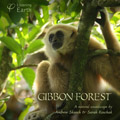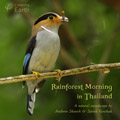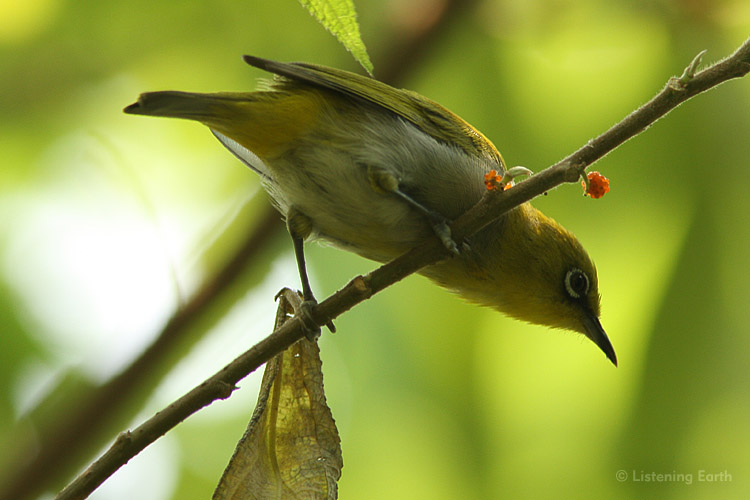

Running Time:
188 min
Release Date:
January 2022
Recording Location:
Umphang Trail, Mae Wong National Park, Western Thailand
If you like this album,
we also recommend:
A Forest Trail to the Burmese Hills
The eastern extent of the Himalayan range collapses into a chaotic geography of ranges and valleys, which arc through southern China and on, turning southward to form the highland barrier between Thailand and Myanmar. This region is the meeting place of some of the world’s great bioregions, and thus home to a great diversity of unique flora and wildlife.
On the summit of one of these ranges, a forest trail threads its way into dense, tropical forest. Somewhere on the horizon not far to the west, but hidden by dense vegetation, lie the Burmese Hills, part of the same habitat system.
In the predawn, a Collared Owlet is heard calling distantly along with the chiming of nocturnal crickets. In the darkness, giant beetles take flight, their wingnoise being audible as they purr past nearby.
Soon, the sharp calls of a Lesser Racket-tailed Drongo herald the dawn chorus, as bulbuls, babblers, warblers and fruit pigeons begin waking. A red-cheeked squirrel scrambles up a tree trunk, giving incisive, spitting calls. With sunrise, light shafts through the humid air, and the place starts to come alive with birdsong. The songs of barbets, niltivas, pittas, scimitar babblers, laughing thrushes, pheasants, flycatchers, woodpeckers, sunbirds and mesias continue into the morning.
This recording will transport you to one of the most ecologically rich areas of the world. Imagine yourself listening among cool fernery, under a dense forest canopy, experiencing a morning alive with exotic birdsong.
Andrew comments:
"Planning our visit to Mae Wong National Park using satellite imagery, I identified a small camping area surrounded by primary forest - hopefully a location which would allow access to an otherwise remote region. It lay at the summit of the range, at the end of a switchback road climbing up from the lowland plains of Central Thailand.
Hiring a vehicle, Sarah and I set out in the company of our driver, Suchat, who turned out to be a character, entertaining us with tall tales of his life as a martial arts practitioner. Eventually, we rounded a final bend and there, just as anticipated, was the small area of grass on which we would pitch our tent.
The Umphang trail that led on into the forest was a continuation of the road, but overgrown. Even as a walking track, I could only follow it for a kilometre before it became impassable. However this was enough to be totally enclosed within primary tropical forest. The place was alive with birdsong, even though many remained hidden among the foliage and only occasionally seen flitting through the canopy.
We spent three days there. This recording coming from the final morning, the most sonically interesting of the three. It is a single, unedited take, from predawn through to that point in the morning when vocal activity declined."
Audio sample of this album
|
1. |
Arboreal Crickets, Microbat, Greater Coucals and Collared Owlet |
5.36 |
|
2. |
Blue Flycatcher Begins the Dawn Chorus |
6.49 |
|
3. |
Dawn Flight of Large Beetles |
4.24 |
|
4. |
Lesser Racket-tailed Drongo |
8.05 |
|
5. |
A Chorus of Barbets, with a Buff-breasted Babbler and a White-browed Scimitar Babbler |
3.04 |
|
6. |
Black-crested Bulbul |
2.59 |
|
7. |
Golden Babbler |
2.23 |
|
8. |
Mountain Imperial Pigeon |
3.49 |
|
9. |
Asian Red-cheeked Squirrel and Greater Yellownape |
5.23 |
|
10. |
Great Barbet and Streaked Yuhinas |
5.26 |
|
11. |
Mountain Bulbuls |
10.16 |
|
12. |
Buff-breasted Babbler Song |
3.04 |
|
13. |
White-browed Scimitar Babbler |
2.22 |
|
14. |
White-necked Laughing-Thrushes |
3.53 |
|
15. |
Small Niltiva |
0.34 |
|
16. |
Rufous-throated Partridge |
3.54 |
|
17. |
Great Barbet |
8.48 |
|
18. |
Golden-throated Barbets |
8.56 |
|
19. |
Rufous-browed Flycatcher and White-throated Bulbuls |
12.13 |
|
20. |
Grey-throated Babbler |
10.12 |
|
21. |
Stripe-breasted Woodpecker and Drongo |
9.50 |
|
22. |
Blue Pitta |
10.06 |
|
23. |
Rufous-browed Flycatcher and Streaked Spiderhunter |
7.48 |
|
24. |
Black-throated Sunbird |
1.20 |
|
25. |
Grey Peacock-pheasant and Bronzed Drongo |
10.30 |
|
26. |
Songs of Buff-breasted Babblers |
6.28 |
|
27. |
Verditer Flycatcher and a Golden-throated Barbet |
7.33 |
|
28. |
Yellow-browed Leaf Warbler |
1.27 |
|
29. |
Buff-breasted Babblers, Alarm Calls |
4.29 |
|
30. |
Asian Red-cheeked Squirrel & Agitated Silver-eared Mesias |
7.59 |
|
31. |
Mountain Bulbuls Return |
8.21 |
Purchase this
album as:
Digital Album
(for immediate download)
Download this album
for as little as
$7.50 -
View Special Deals
(Prices AU$, exGST)
Mp3:
Mp3 is a universal audio format, playable on iPods, computers, media players and mobile phones.
Mp3 is a compressed format, allowing smaller filesizes, offering faster download times and requiring less storage space on players, but at some expense to the audio quality. Many listeners can't really hear the difference between mp3 and full CD-quality audio, and hence its convenience has lead to it becoming the default option for audio.
Our albums are generally encoded at around 256kbps (sometimes with VBR), balancing optimal audio quality without blowing out filesizes excessively. We encode using the Fraunhoffer algorithm, which preserves more detail in the human audible range than the lame encoder.
Our mp3 files are free of any DRM (digital rights management), so you can transfer them to any of your media technology. You've paid for them, they're yours for your personal use without restriction.
Mp3 files can be burned to disc, either as an mp3 disc, or an audio CD after converting them to a standard audio (.wav or .aif) format first.
FLAC:
FLAC is a high-quality audio format, allowing CD-resolution audio. It is ideal if you wish to burn your files to a CDR, or listen over a high resolution audio system. However files usually require special decoding by the user before playing or burning to disc.
FLAC (Free Lossless Audio Codec) is a LOSSLESS compressed audio format. This means that it preserves the full audio quality of a CD, but optimises the filesize for downloading. Typically, file sizes of around 60% are achieved without any degradation or loss of audio quality from the source files at the CD standard of 16bit/44.1kHz.
Obviously the file sizes are larger than for the mp3 version - usually around 300-400Mb for an album, compared to 100Mb for an mp3 album.
In addition, you'll need to know what to do with the files once you've downloaded them. In most cases you'll want to decode the files to wav or aiff, either to import into programs like iTunes, or burn to CDR. Some programs will play flac files natively.
There is a lot of information about flac online (eg: http://flac.sourceforge.net/)





 Alternate audio link
Alternate audio link 